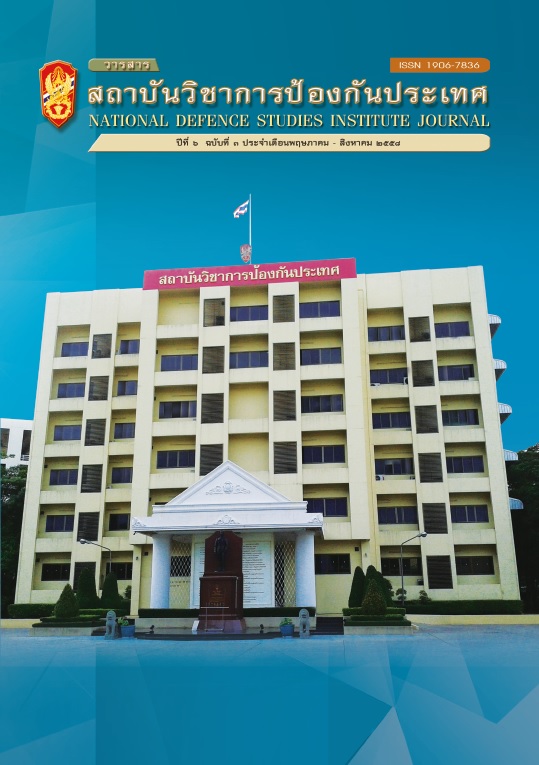กระบวนการสร้างสันติสุข ในพื้นที่ขัดแย้งจังหวัด ชายแดนภาคใต้ กรณีศึกษา หมู่บ้านซือเลาะห์ ตำบลเรียง อำเภอรือเสาะ จังหวัดนราธิวาส
Main Article Content
บทคัดย่อ
นับตั้งแต่เหตุการณ์กลุ่มผู้ก่อเหตุรุนแรงบุกเข้าโจมตีค่ายกรมหลวงนราธิวาสราชนครินทร์ (ค่านปิเหล็ง) กองพันพัฒนาที่ ๔ อำเภอเจาะไอร้อง จังหวัดนราธิวาส เมื่อวันที่ ๔ มกราคม ๒๕๔๗ จวบจนถึงปัจจุบันสถานการณ์การก่อเหตุรุนแรงในพื้นที่ จังหวัดชายแดนภาคใต้ยังคงมีอย่างต่อเนื่อง
การวิจัยนี้ มีวัตถุประสงค์ เพื่อศึกษากระบวนการก่อเหตุรุนแรง ในพื้นที่จังหวัดชายแดนภาคใต้ และศึกษากระบวนการ สร้างสันติสุขในพื้นที่ หมู่บ้านซือเลาะห์ ตำบลเรียง อำเภอรือเสาะ จังหวัดนราธิวาส ซึ่งเป็นพื้นที่ที่ผู้วิจัยได้ไปปฏิบัติภารกิจใน ห้วงปี ๒๕๕๑ – ๒๕๕๒ โดยเป็นการวิจัยเชิงคุณภาพ ด้วยการนำข้อมูลปฐมภูมิจากการสัมภาษณ์เชิงลึกกลุ่มบุคคลที่มีส่วนร่วม ในกระบวนการสร้างสันติสุขในพื้นที่ จำนวน ๑๒ คน และข้อมูลทุติยภูมิ จากการศึกษาแนวคิด ทฤษฎี และงานวิจัยที่เกี่ยวข้อง มาวิเคราะห์ด้วยหลักฐานเชิงประจักษ์จากประสบการณ์ของผู้วิจัย เพื่อประมวลเป็นข้อเสนอแนะ และตัวแบบกระบวนการสร้าง สันติสุขที่เหมาะสมกับพื้นที่ขัดแย้ง จังหวัดชายแดนภาคใต้
ผลการวิจัย พบว่า การก่อเหตุรุนแรงในพื้นที่จังหวัด ชายแดนภาคใต้ เกิดจากขบวนการ BRN–Coordinate อาศัย เงื่อนไขวงจรความรุนแรงทางสังคม อันเนื่องมาจากชาติพันธุ์ ประวัติศาสตร์ และอัตลักษณ์ท้องถิ่น ผนวกกับการเบี่ยงเบนหลักศาสนาอิสลาม เพื่อเชื่อมโยงการต่อสู้ไปสู่หนทางของศาสนา โดยมีเป้าหมายสูงสุด คือเอกราช และการรื้อฟื้นรัฐปัตตานีดารุสซาลาม นอกจากนี้ ยังมีการขับเคลื่อนความรุนแรง โดยโครงสร้างองค์กรลับที่จัดตั้งขึ้น ซึ่งประกอบด้วยโครงสร้าง กองกำลังติดอาวุธ (MAY) ทำหน้าที่ก่อเหตุรุนแรงในพื้นที่ ด้วยยุทธวิธีการรบแบบกองโจร และการก่อวินาศกรรมใน ชุมชน และโครงสร้างมวลชนจัดตั้ง (MASA) ที่จัดตั้งหมู่บ้าน“อาเยาะห์” ทำหน้าที่เป็นฐานที่มั่น และให้การสนับสนุนกอง กำลังติดอาวุธ โดยมีองค์กรจัดตั้งที่เรียกว่า “เปอร์กาเดส” (PERKADES) ทำหน้าที่บ่มเพาะ และจัดหาสมาชิกใหม่ให้ กับขบวนการ เพื่อให้ สามารถดำรงการต่อสู้ได้อย่างต่อเนื่อง
ข้อเสนอแนะ และตัวแบบกระบวนการสร้างสันติสุขในพื้นที่ขัดแย้ง จังหวัดชายแดนภาคใต้ ในระดับหมู่บ้าน ควรมี วัตถุประสงค์ในการรองรับนโยบาย “การเมืองนำการทหาร” คือ มุ่งไปสู่การเอาชนะจิตใจประชาชน โดยกำหนดเครื่องมือ สำคัญในการขับเคลื่อน ได้แก่เจ้าหน้าที่รัฐ ๓ ฝ่าย (พลเรือน ตำรวจ และทหาร) ภาคประชาสังคม และประชาชนในพื้นที่ โดยรัฐสนับสนุนงบประมาณ และทรัพยากร พร้อมวิธีปฏิบัติ ซึ่งประกอบด้วยกลุ่มงานที่มีการปฏิบัติตามลำดับขั้น จำนวน ๔ กลุ่มงาน ได้แก่ กลุ่มงานการควบคุมสถานการณ์ และสร้าง ความปลอดภัย, กลุ่มงานการเสริมสร้างความเข้าใจเชิงรุก, กลุ่มงานเสริมสร้างอำนาจรัฐให้เข้มแข็ง และกลุ่มงานพัฒนา คุณภาพชีวิตและสร้างความยั่งยืน โดยมีกลุ่มงานติดตามและ ประเมินผล สำหรับควบคุม และกำกับการปฏิบัติตลอดห้วง กระบวนการ เพื่อนำไปสู่การยุติความรุนแรง คุณภาพชีวิตที่ ดีของประชาชน สันติสุขที่ยั่งยืน เอกภาพ และ บูรณภาพแห่ง ดินแดนราชอาณาจักรไทยต่อไป
Peace Building Process in Southern Border, Thailand: Case Study for Soelor Village, Rieng Sub-District, Ruso District, Narathiwat
Since the raid incident at Khai Kromluangnarathiwatrajanagarindra (KhaiPileng), the 4th development battalion, Joreirong district, Narathiwat on January 4, 2004, unrest and violence has continued to occur in the southern-border provinces in Thailand.
The objectives of this research were to study the process of violence formation in the southern-border areas and to study the process of peace building in the area of Soelor village, Rieng sub-district, Roesor district, Narathiwat province, which was the area where the researcher was on the mission during 2011-2012. This research was a qualitative study with the primary data obtained from in-depth interviews with 12 individuals involved in peace-building process in the region and the secondary data obtained from the study of concepts, theories and related researches. These data were analyzed with empirical evidence from the on-site experience of the researcher in order to compile the recommendation and the model of the peace-building process that was appropriate to the conflicted area in the southern-border provinces of Thailand.
The study found that the violence incidents were created by the BRN-Coordinate using social conflicts in origins, history, and identities, together with the deviations in Islamic religious doctrine. The ultimate goals of the violence are independence and resurrection of the State Pattani Darul Salam. The violence incidents were driven and supported by several hidden organizations, such as MAY, MASA, and PERKADES. MAY is an armed-force organization which creates violence using guerrilla tactics and community sabotage. MASA is an established-mass organization which establishes the Ary or village as the strong hold supporting the armed-force organization. PERKADES is an organization whose responsibilities include incubation and recruitment of new members for creating continuous violence.
Meanwhile, the suggested model of peace-building process at the village level in the southern-border provinces in Thailand should support the politics-leading-military policy to win people’s hearts. The success of this model relies on strong participation of civilian, police, and military government staffs, civil societies, and local residents, with the government providing budget, resources, and strategic methods. The strategic methods require four sequential working groups. The first group is for controlling situations and safety security. The second group is for enhancing understanding using a proactive approach. The third group is for reinforcing the government power, and the fourth group is for improving the quality of life and sustainability. Performance of these four groups will be monitored and evaluated throughout the processes by the monitoring and evaluating working group. This suggested model may be used asa guideline for peace-building processes in the southern-border provinces in Thailand for ceasing the violence, better quality of life, sustainable peace, and unity of the kingdom of Thailand.
Article Details
บทความ ภาพ ตาราง กราฟ ข้อเขียน หรือความคิดเห็นในวารสารฉบับนี้เป็นของผู้เขียนไม่ผูกพันกับสถาบันวิชาการป้องกันประเทศ และทางวิชาการแต่อย่างใด


